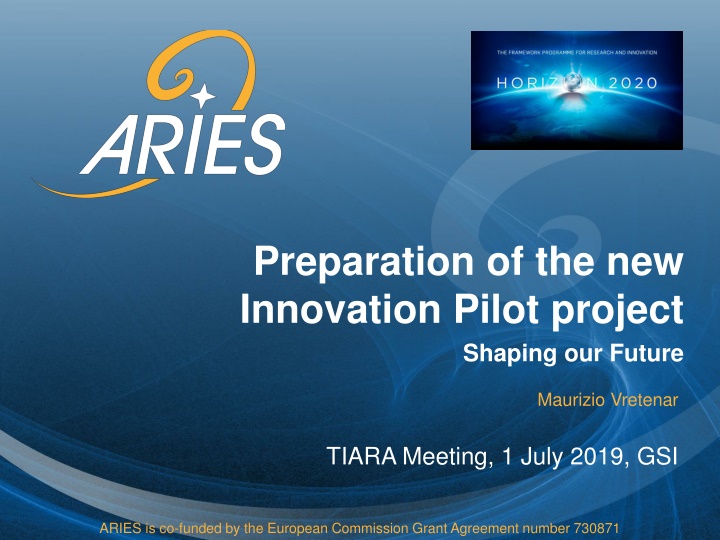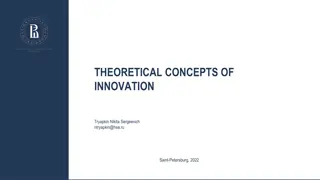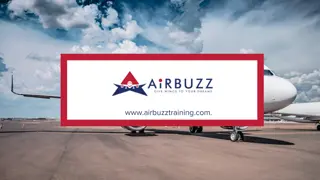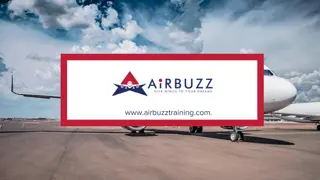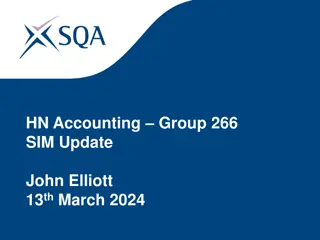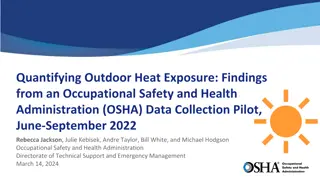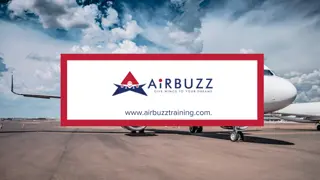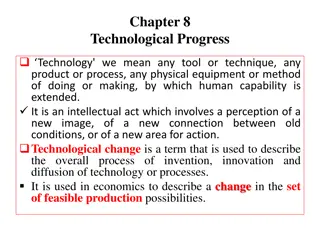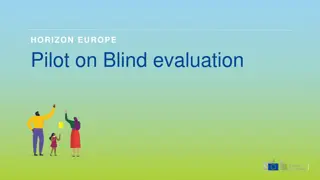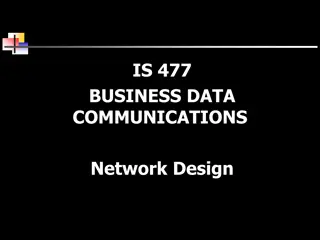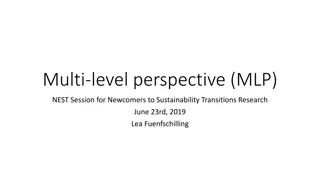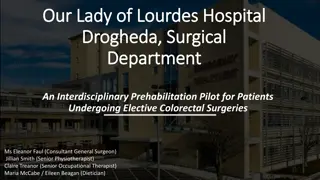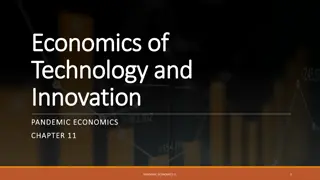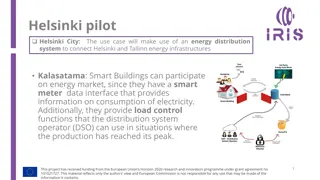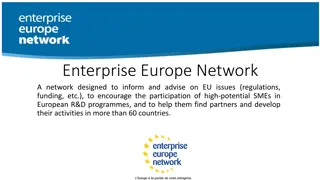Innovation Pilot for RI Network Technological Developments
Research infrastructures across Europe are enhancing their capabilities through innovative technology developments in collaboration with industry and SMEs. This project aims to kick-start a common roadmap for technological advancements, promoting co-creation for improved services and socio-economic impact. Key components include technological roadmaps, technology development, and prototyping to advance research infrastructures and foster industry partnerships.
Download Presentation

Please find below an Image/Link to download the presentation.
The content on the website is provided AS IS for your information and personal use only. It may not be sold, licensed, or shared on other websites without obtaining consent from the author.If you encounter any issues during the download, it is possible that the publisher has removed the file from their server.
You are allowed to download the files provided on this website for personal or commercial use, subject to the condition that they are used lawfully. All files are the property of their respective owners.
The content on the website is provided AS IS for your information and personal use only. It may not be sold, licensed, or shared on other websites without obtaining consent from the author.
E N D
Presentation Transcript
Preparation of the new Innovation Pilot project Shaping our Future Maurizio Vretenar TIARA Meeting, 1 July 2019, GSI ARIES is co-funded by the European Commission Grant Agreement number 730871
The Innovation Pilot in the RI Workprogramme The H2020 Workprogramme 2018-2020 for European research infrastructures with all details of the 2020 calls is in the final verification phase after approval on May 7th. We are going to apply to the call INFRAINNOV-04-2020: Innovation pilots that foresees 3 projects of 10 M each addressing innovation in 3 domains: light source technologies, detector technologies, accelerator technologies. Non-competitive call, each community is expected to submit one project that will be approved if evaluated beyond an acceptance threshold. TIMELINE: Open call 28 November 2019 Deadline for submission 17 March 2020 Result of evaluation end of 2020 Possible project start May 2021 (at end of ARIES on 30 April 2021) 2
Contents of the new project (from workprogramme) Specific Challenge: Pan-European Research Infrastructures use more and more sophisticated technologies not available on the market, which require ad-hoc developments and often the use of large-scale platforms combining R&D (Research and Development), integration and validation. These platforms can also provide longer-term visibility and involvement of European industry in scientific and technological advancements and therefore ensure greater socio-economic impact. Key points: RI Networks Technological developments in partnership with industry Use of large scale platforms Scope: Funding will be provided to research infrastructure networks to kick-start the implementation of a common strategy/roadmap for technological developments required for improving their services through partnership with industry. Proposals should then involve research infrastructures, industry and SMEs to promote innovation and knowledge sharing through co-creation of needed technical solutions and make use, when appropriate, of large- scale platforms combining R&D (Research and Development), integration and validation for the technological developments. Proposals should address: if not already done,the identification of key techniques and trends which are crucial for future construction and upgrade of the involved Research Infrastructures and the definition of roadmaps and/or strategic agendas for their development, in close partnership with the industrial partners, especially with innovative SMEs; 3 components: 1. Technological roadmaps in partnership with industry 2. Development of technologies. 3. Prototyping of technologies. the development of the identified fundamental technologies or techniques underpinning and arising from the efficient and joint use of the involved research infrastructures, taking into due account resource efficiency and environmental (including climate-related) impacts. the prototyping of higher performance methodologies, protocols, and instrumentation, including the testing of components, subsystems, materials, and dedicated software, needed to upgrade the involved research infrastructures, construct their next generation, or develop new advanced applications. 3
Additional remarks and requirements The Workprogramme text has been slightly modified following our requests, to include accelerator applications. Is required a sustainability plan for further implementation of the strategies defined in the project (i.e. a longer-term vision). Proposals should reinforce partnership with industry via transfer of knowledge and other dissemination activities, activities to promote the use of research infrastructures by industrial researchers, involvement of industrial associations in consortia or in advisory bodies. Projects under this action will be complementary between them (i.e. with LEAPS and AIDA-3) and should cooperate with ATTRACT and avoid overlaps. Proposals should foresee a dedicated task or work package and earmark appropriate resources. Proposals should also build on results from past/ongoing projects, such as AMICI, or the one funded under topic INFRAINNOV-02-2019. 4
Proposed structure of the new Pilot Following the text of the call, the project may be divided in 3 types of components: strategies, developments, prototypes. The Working Group on Sustainability of TIARA/ARIES has proposed an indicative repartition between the 3 components, and has advised two calls for projects (at project start and after 1 year) Activity TRL Initial proposal (2021-25) Second stage (2022-25) Individual EC contribution N. of projects Total budget Individual EC contribution N. of projects Total budget Strategies 300 k 5 1.5 M Developments 2 3 - 4 100 k 15 1.5 M 100 k 10 1.0 M Prototypes 4 5 - 6 500 k 6 3.0 M 500 k 4 2.0 M TOTALS 6.0 M 3.0 M - The repartition of actions is purely indicative, the final decision will be taken based on the proposals received. In addition, we need 3 general Workpackages: o Management and Coordination o Training and Education o Industry involvement and knowledge transfer - 5 + coordination, training, KT
Call for proposals Letter sent on May 15th to all mailing lists of our EU accelerator projects, asking to spread the information. Was included a template form (5 pages) to be filled in to allow the evaluation of the proposals. Transparent process: Set-up a section of the ARIES Web Site with all the information on the internal call for proposals (https://aries.web.cern.ch/content/accelerator-innovation) and a mail address for questions and submissions innovation.pilot@cern.ch 6
Basic principles of the new project Although we have organised a bottom-up call for proposals, we do not want an unstructured collection of mini-projects, originated in one single institute, with some additional industrial partners ( la ATTRACT ). We must keep some important dimensions of our strategy for accelerator development that have emerged from our experience with Integrating Activities: 1. A project structured in well-identified and coordinated themes . 2. European integration, in particular for smaller countries. 3. Connections and cross-fertilisation between laboratories, universities, industry. 4. Long-term time span of the R&D, beyond the needs of specific ongoing projects. 5. Co-funding, projects integrated in the work programme of our laboratories. 6. Partial two-stage submission as experienced with the ARIES proof-of-concept. This strategy must be reflected by our Evaluation Criteria. 7
A Project structure in Themes The different actions (strategies, developments, prototypes) can be organised in Themes, with a theme (workpackage) coordinator. The ideal configuration would be having for each theme a strategy/roadmap and a number of projects at different TRL level. + additional Themes (workpackages) for coordination, training, KT Theme 1 Theme N Theme 2 Strategy Strategy Strategy Development Development Development Development Development Development Prototype Prototype Prototype Governance and Project follow-up We need a different governance structure to follow-up the progress of the individual actions and to evaluate their results (again, we don t want to follow the ATTRACT model). Ideas: Project Coordinator supported by a Follow-up Committe that will report progress to the Governing Board. Funding (2 or more allocations) can be stopped or delayed in case of indentified problems. 8
Evaluation of actions criteria Proposed criteria for evaluation and points: 1. Scientific and technological excellence (10 pts ?) 2. Impact on Research Infrastructure users and/or on society (5 pts.) 3. Methodology (5 pts.) 4. Innovation content (5 pts) 5. Transnationality and integration (5 pts) 6. Co-funding rate (5 pts.) 7. Risk management (5 pts.) 8. Cost vs. Impact (5 pts.) 9. Extent and quality of industry involvement (5 pts.) 10.Efficent use of resources and environmental impact (5 pts.) 11.Coherence with the priorities of the community (5 pts.) 12.Continuity with previous programmes (ARIES, AMICI, etc) (5 pts.) For each criterion, will be prepared a guide for evaluators with an explanation of the requirements to have 1, 3 or 5 points. 9
Evaluation committee Proposal: the members of the Innovation Evaluation Committee (IEC) are nominated by the Directors of the 11 laboratories or consortia that signed the TIARA MoU [CEA, CERN, CNRS, CIEMAT, DESY, GSI, INFN, PSI, STFC, Uppsala University for Nordic consortium, HN Institute of Nuclear Physics for Polish consortium]. The committee should includes at least 2 industry representatives nominated by TIARA. Committee of 13 members + 1 chair nominated by TIARA. The members will individually evaluate the proposals (all or a subset depending on the number of proposals received) between 1 and 15 October. 1st Committee meeting end September 2nd Committee meeting end October Share of work and conflict of interest: In case of a large number of proposals, each proposal will be evaluated by at least 3 committee members, chosen by the Chair on the basis of competence and of potential conflicts of interest (e.g. a member of the committee cannot evaluate proposals where his/her own laboratory is involved!) 10
Process and timeline Timeline: 15 May sent letter and submission form to all institutes having participated in previous programmes. 31 August submission deadline. 31 August: deadline for nomination of Committee members. 30 September pre-analysis and classification of submissions completed. 31 October selection of projects completed. 30 November after a negotiation phase, structure of project complete and start editing. 1. Bottom-up call for proposals for activities to be included in the Innovation Pilot. Seting up of an evaluation committee that will analyse and prioritise the proposals. First filtering by proposing merging or rescaling of proposals. Evaluation of proposals and definition of a first ranking. Final selection of proposals by the committee, taking into account the overall coherence of the project, and identification of the themes . The final ranking is published on the TIARA and ARIES web sites and successful proposals are invited to submit a detailed proposal. 2. 3. 4. 5. 6. 11
Requests to TIARA 1st July 2019 1. Provide feedback on the methodology, the evaluation criteria, and the related number of points. Endorse the overall process. Nominate the chair of the Evaluation Committee and two industry members (with some reserve names). Invite the Directors of the TIARA Laboratories (who and at what level?) to nominate their representatives in the Evaluation Committee. Nominate the coordinator for the proposal preparation. Give some input for the name of the new project: Accelerator Innovation (AccInn)? ARIES+ ? ? 2. 3. 4. 5. 6. 12
